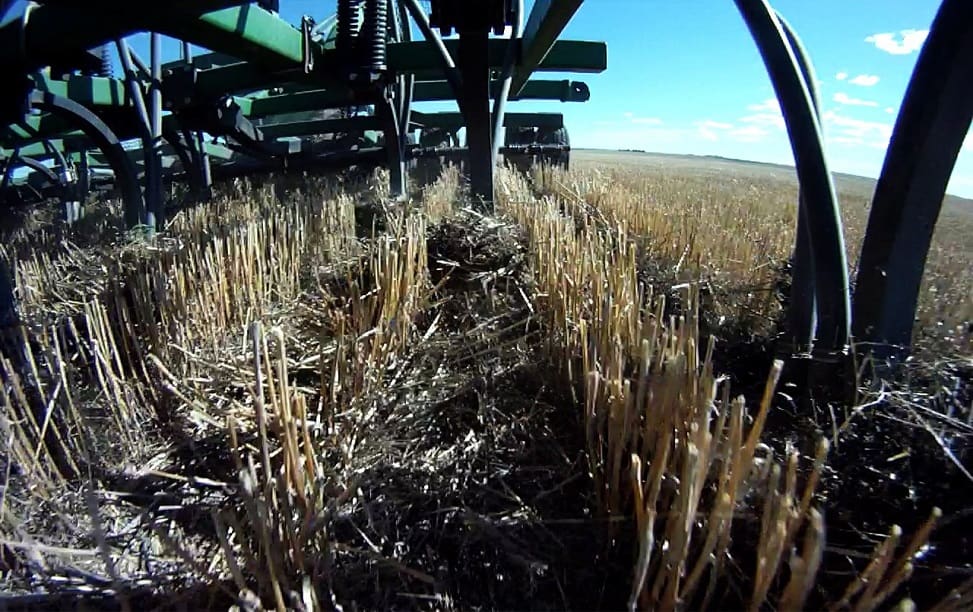
Inter-row planting alongside stubble rows in a controlled traffic farming system on Steve Larocque’s farm in Alberta, Canada.
THE concepts of ‘fence row farming’ and ‘strip farming’ could be on the watch list for Australian farmers if results from Canada showing the techniques have potential to significantly boost crop yields are any guide.
Speaking at the Controlled Traffic Farming (CTF) conference in Ballarat, Victoria, Canadian farmer and Beyond Agronomy consultant, Steve Larocque, said fence row farming was a concept he discovered by chance on his farm at Three Hills in Alberta nearly a decade ago.
In the early stages of bedding down a CTF system at the time, Mr Larocque was working out ways to adjust his sowing equipment to manage crop residues and utilise the sowing accuracy the CTF system provided.
While most farmers reset their machines to plant the next crop mid-way between the previous crop’s stubble rows, he sought to tap into the higher soil moisture levels closer to the stubble by moving the sowing rows only slightly to the side of the stubble.
“We moved the drill over only 75 millimetres. We do that each year. It creates a nutrient dense, highly porous structure where all the root channels go in the same spot and all the fertiliser is concentrated into the same strip on the paddock instead of being spread across,” he said.
“If you want to find moisture anywhere in a paddock, you will find it under last year’s stubble row. There will always be more consistent moisture there.
“Therefore, the soil flows over the openers much better, the seed placement is much better and we have seen improvements in germination and emergence.”

Under the ‘fence row farming’ system on Steve Larocque’s Canadian farm, crops are sown only 75mm to the side of the previous crop’s stubble row.
Mr Larocque said the term ‘fence row farming’ was adopted because the system mimicked, in miniature, the effect old fence lines had in trapping drifting soil, creating a deeper profile and holding more moisture.
“Think of old fence lines when you rip them up to amalgamate paddocks into one. You always find the old areas where the fence line was are higher in yield, higher in moisture and always perform better than the rest of the paddock,” he said.
“That is what we try to mimic by planting on or right beside last year’s stubble row every year.”
Mr Larocque said the challenge for running such a system in Canada was that after harvest the freeze set in, so there was very little biological activity from harvest to sowing.
He said it would be equally possible to run a fence-row farming system in Australia, but there would also be challenges.
“Your stubble breaks down a lot faster and dislodges quickly, which can plug your drill, so there will be some machinery issues,” he said.
Strip cropping focus on biology
Mr Larocque said producers in Canada were also keeping a close eye on a related system of intensive strip cropping developed by a farmer in Ontario in eastern Canada which encouraged the production of crop-specific biological organisms.
The effect has been a dramatic improvement in- crop yields.
Under the system, the farmer strip crops with alternating sowing passes of corn and soybeans, resulting in nine-metre strips of corn interspersed with nine-metre strips of soybeans.
“He flip flops his crops. He has been doing CTF for 20 years. He has built up very specific biology that are conducive to corn and soybeans,” Mr Larocque.
While it is a monoculture way of building up biology at a time when convention calls for greater diversity, the system is achieving impressive results.
“(Scientists) started to look at the difference in biology between neighbouring farms and this farm because this farm produced 75 per cent more grain yield one year than everybody else, which is staggering, even though the nutrient supplies were very similar.”
Mr Larocque said tests had been conducted where soil samples from both the strip-cropped farm and neighbouring conventional farms were pasteurised to take the biological organisms out of the equation.
“They heated it to 60 degrees and nuked everything. They found no difference in plant growth when they grew plants like wheat, canola, peas and corn out in that medium,” he said.
“Yet on the soils they didn’t pasteurise, they saw a big increase in volume in the crops. It told us it wasn’t just the soil depth or nutrient response that made the difference, it was actually a biological response that was the difference between the strip-cropped and neighbouring fields, even though the neighbouring conventional fields had a greater diversity of bacteria and fungi.
“But what was on the strip cropping farm was 10 times the number of biology that were specific to the crops. So, there were less bacteria and fungi, but 10 times as much of the specific biology as the neighbouring fields.”
Early days for CTF uptake in Canada
Mr Larocque said the adoption of CTF in Canada was still in its early days and was quite “fragmented”.
“No-one has a true sense of how many people are doing CTF. If I was to guess, it might be 50,000 hectares, so not a tremendous amount. We really didn’t start doing any research on it until 2013,” he said.
“People are still coming to the realisation that the freeze/thaw cycle doesn’t do as much as they think it does (to ameliorate soil compaction).”
Grain Central: Get our free cropping news straight to your inbox – Click here


Philip Kerr at Oaklands NSW was planting peas and faba beans right next to the previous years cereal stubble plant rows for the same reasons over a decade ago.